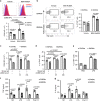Distinct fate, dynamics and niches of renal macrophages of bone marrow or embryonic origins
- PMID: 32385245
- PMCID: PMC7210253
- DOI: 10.1038/s41467-020-16158-z
Distinct fate, dynamics and niches of renal macrophages of bone marrow or embryonic origins
Abstract
Renal macrophages (RMs) participate in tissue homeostasis, inflammation and repair. RMs consist of embryo-derived (EMRMs) and bone marrow-derived RMs (BMRMs), but the fate, dynamics, replenishment, functions and metabolic states of these two RM populations remain unclear. Here we investigate and characterize RMs at different ages by conditionally labeling and ablating RMs populations in several transgenic lines. We find that RMs expand and mature in parallel with renal growth after birth, and are mainly derived from fetal liver monocytes before birth, but self-maintain through adulthood with contribution from peripheral monocytes. Moreover, after the RMs niche is emptied, peripheral monocytes rapidly differentiate into BMRMs, with the CX3CR1/CX3CL1 signaling axis being essential for the maintenance and regeneration of both EMRMs and BMRMs. Lastly, we show that EMRMs have a higher capacity for scavenging immune complex, and are more sensitive to immune challenge than BMRMs, with this difference associated with their distinct glycolytic capacities.
Conflict of interest statement
The authors declare no competing interests.
Figures








References
Publication types
MeSH terms
Substances
Grants and funding
- T32 MH079785/MH/NIMH NIH HHS/United States
- R01 HL138749/HL/NHLBI NIH HHS/United States
- P51 OD011104/OD/NIH HHS/United States
- U54 GM104940/GM/NIGMS NIH HHS/United States
- R01 NS094834/NS/NINDS NIH HHS/United States
- P01 DA037830/DA/NIDA NIH HHS/United States
- R01 HL147565/HL/NHLBI NIH HHS/United States
- R01 DK113775/DK/NIDDK NIH HHS/United States
- R01 HL141132/HL/NHLBI NIH HHS/United States
- R21 AG063345/AG/NIA NIH HHS/United States
- P20 GM103629/GM/NIGMS NIH HHS/United States
- R01 HL148836/HL/NHLBI NIH HHS/United States
- R01 HL130233/HL/NHLBI NIH HHS/United States
- R21 OD024931/OD/NIH HHS/United States
LinkOut - more resources
Full Text Sources
Molecular Biology Databases
Research Materials
Miscellaneous

